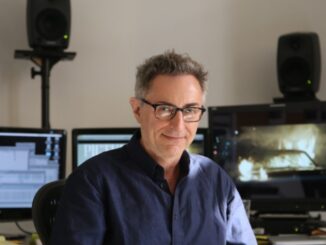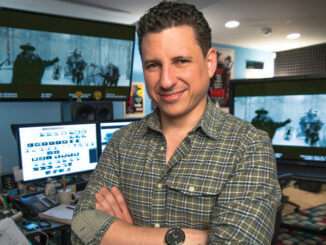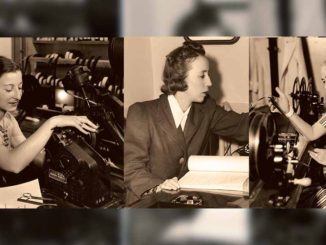
By Peter Tonguette
Like few films in recent years, Barry Levinson’s new film “The Survivor” illustrates the personal costs of man’s inhumanity to man.
The true-life drama, which premiered earlier this year on the HBO Max streaming service, depicts the physical and psychological bruises borne by Harry Haft, a Jewish man born in Poland who, during World War II, was sent to a Nazi concentration camp. There, Haft was forced by a Nazi officer to become a boxer and participate in matches with others in the camp. Haft made it out of the camp with his life, but the trauma of his experiences remained with him even after he settled in New York and had a brief career in the ring.
In “The Survivor,” actor Ben Foster plays Haft, whose story is told in an elaborate flashback structure seamlessly executed by picture editor Douglas Crise, ACE. Best known for such critically acclaimed films as Alejandro G. Inarritu’s “Babel” (for which he was nominated for an Oscar with co-editor Stephen Mirrone, ACE) and “Birdman,” and Harmony Korine’s “Spring Breakers,” Crise shifts between three time periods without losing sight of the man at the center. The film, which premiered at the Toronto International Film Festival last fall, co-stars Vicky Krieps, John Leguizamo, and Peter Sarsgaard.
CineMontage recently spoke with Crise about collaborating with Levinson, the Oscar-winning director of “Rain Man,” and finding the best way to bring Haft’s compelling story to the screen.
CineMontage: How did you become involved in “The Survivor,” and what appealed to you about the project?
Douglas Crise: I had done a movie quite a few years ago called “Arbitrage,” and one of the producers, Kevin Turen, recommended me to Barry. I hadn’t met him, so I interviewed on the phone. Barry was living in New York at the time. He hired me.
The script was really good, and I thought that this was going to be a strong, emotional film. I did connect with it that way. I have to say, getting a call from Barry Levinson was a dream. I remember living in Pennsylvania and seeing him get his Oscar for “Rain Man” and never dreaming that I would get to work with the guy someday. I knew this was going to be a great piece of work, and I was very excited about doing it.
Barry would tell me when we were working about his uncle who stayed with him who would have nightmares from post-traumatic stress. He never knew his uncle had been through the concentration camps, and he thought this guy was a strange guy who was screaming in the middle of the night. He had a deep connection to it. My father and my uncle were in the war, and my uncle was wounded in Germany and lost his hearing. He never spoke of the horrors he saw. I remember when the first Iraq War started, the one that everyone thought was the good one, he said, “None of this war stuff is any good.”
CineMontage: The movie was shot way back in 2019 in multiple locations: Budapest for the concentration camp scenes; New York for a scene on Coney Island and some exteriors; and Georgia for the scenes of Harry in 1963. What was the schedule like?
Crise: Initially, they had gone to Budapest to shoot all of the concentration camp scenes for two weeks. Ben had lost a lot of weight. I work in Los Angeles, so for that two weeks, they just sent in the footage and we cut it together. Then I flew to New York to meet Barry, and we worked on that two weeks’ worth of footage for two weeks. I got to know him a little bit, and we experimented by finding some found footage so we could play around to fill in gaps sometimes.
They took about five weeks off from the shoot so Ben could put some weight on, and then we all flew to Budapest, a lovely city. I got to work in Budapest, and had a great assistant, Nora [Richter]. They were shooting on different locations, and Barry would try to come in about once a week, maybe twice if he had a day off. Then we came back to New York to continue working, and they still hadn’t shot the New York stuff. We had some time to work on the Budapest shoot while they planned the New York part, where they go to Coney Island. We shot that, and then there was a shoot in Georgia a couple months later. My assistant in LA and New York was Keith Sauter, with whom I have worked on many projects.
CineMontage: Is it unusual for a project to have so many stops and starts in different locations?
Crise: On “Babel,” they shot the Morocco scenes and then there was a little bit of a break of a couple weeks, and then they went to Mexico, and then there was a big break of several weeks before they went to Japan. On “The Survivor,” it never felt like we stopped and started too much. The only real stop for me was between when they shot the concentration camp and then we went to Budapest. I had three weeks off, so I had a hiatus built into that. But otherwise, I was there on the show all the time, and we were always reworking stuff.
CineMontage: How did you and Levinson work together?
Crise: One of the great things about Barry is he doesn’t dictate your edit. He lets you do it. I build the whole movie, and then he comes in and says, “I remember a shot” or “Could we try to make this moment more emotional?” He doesn’t tell me how to do it. That’s how great directors do it. Literally, there was only twice on the entire film where he said, “Could I see everything I shot?” Some directors will want to sit down and watch all the dailies and reassemble the movie from scratch for some reason, and not trust their editor.
CineMontage: The movie very artfully uses flashbacks, both extended flashbacks and very quick momentary flashbacks to suggest Harry’s state of mind. Was all of that built into the script?
Crise: The structure of the film was indicated in the script: It starts in 1963, and goes back to 1949, and within 1949, which the basis of most of the story, are flashbacks to the war. But there was a lot of experimenting with that. We did a lot of different restructuring ideas. One of the things we learned early on was that we needed to bring the horror of his first boxing match in the concentration camp earlier in the film. Initially it was scripted to be much later, but when he’s telling Emory the reporter [Peter Sarsgaard] about it, there wasn’t supposed to be a fight at that point. We didn’t see the first fight. But we had to see what happened. There was a lot of experimenting of going back and forth, and trying to put flashbacks in the fights.
CineMontage: Is it a challenge to keep the audience with you as you’re shifting between three time periods?
Crise: It can be. I think in some respects this had a little bit of that, but I never found the movie too confusing. I know that some people were confused at different points. They would say, “I don’t know where I’m at,” or “Why are we starting here and ending here?” But I never found this movie to be confusing, because Ben looks so different, and the time periods look so different.
CineMontage: Shooting wrapped in 2019, but the film didn’t come out until last fall.
Crise: This film has been through a lot of different changes. They even made some changes after I was done. I was finished in 2019, but it didn’t come out until this year. But the movie always worked. It was almost a movie you couldn’t screw up. The movie was so emotional—there were moments where I would be working on it and would tear up—that it always worked, even when it was 2 hours and 45 minutes. It was a super-long assembly, but you knew you had a movie in there. It didn’t take long to tighten it up, and we hung around the 2-hour and 20-minute version for quite a while. The DNA of the film is good. Sometimes when the DNA isn’t good, you rework and rework it, and you try everything.
CineMontage: What do you hope audiences take from “The Survivor”?
Crise: The atrocities of how human beings treat each other, and how we can’t let that happen. And it’s happening again—it’s always happening. The people who want power and want to take over the world, basically, use things like simple hatred of another human being and the dehumanization of them. I hope people can see this and realize this is not a history story, in a way. This is not a story of something that happened 80 years ago that is not happening right now. [We still have] the demagoguery of leaders who think they can convince you that you should hate your fellow human beings, and you follow that and get so in their lane that you can justify anything.






